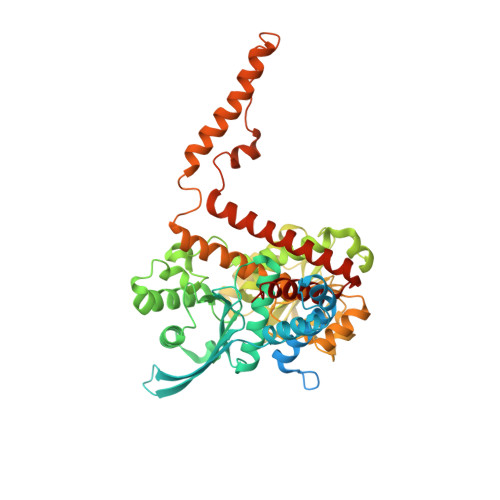A novel mechanism of V-type zinc inhibition of glutamate dehydrogenase results from disruption of subunit interactions necessary for efficient catalysis.
Bailey, J., Powell, L., Sinanan, L., Neal, J., Li, M., Smith, T., Bell, E.(2011) FEBS J 278: 3140-3151
- PubMed: 21749647
- DOI: https://doi.org/10.1111/j.1742-4658.2011.08240.x
- Primary Citation of Related Structures:
6DHM, 6DHN - PubMed Abstract:
Bovine glutamate dehydrogenase is potently inhibited by zinc and the major impact is on V(max) suggesting a V-type effect on catalysis or product release. Zinc inhibition decreases as glutamate concentrations decrease suggesting a role for subunit interactions. With the monocarboxylic amino acid norvaline, which gives no evidence of subunit interactions, zinc does not inhibit. Zinc significantly decreases the size of the pre-steady state burst in the reaction but does not affect NADPH binding in the enzyme-NADPH-glutamate complex that governs the steady state turnover, again suggesting that zinc disrupts subunit interactions required for catalytic competence. While differential scanning calorimetry suggests zinc binds and induces a slightly conformationally more rigid state of the protein, limited proteolysis indicates that regions in the vicinity of the antennae regions and the trimer-trimer interface become more flexible. The structures of glutamate dehydrogenase bound with zinc and europium show that zinc binds between the three dimers of subunits in the hexamer, a region shown to bind novel inhibitors that block catalytic turnover, which is consistent with the above findings. In contrast, europium binds to the base of the antenna region and appears to abrogate the inhibitory effect of zinc. Structures of various states of the enzyme have shown that both regions are heavily involved in the conformational changes associated with catalytic turnover. These results suggest that the V-type inhibition produced with glutamate as the substrate results from disruption of subunit interactions necessary for efficient catalysis rather than by a direct effect on the active site conformation.
Organizational Affiliation:
Gustavus Adolphus College, St Peter, MN, USA.


















